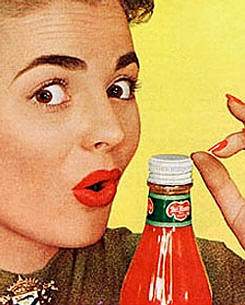|
|
|
|
|
LECCION 9 - PAGINA 2
índice del curso
página anterior
página siguiente |
|
|
|
 |
Comprehension |
 |
|
|
ACTIVITY 40:
You are going to read a
magazine article about women in advertisements. For questions
1-5, choose the answer (A, B, C or D) which you think best fits according to
the text. Then check the correct answers. |
|
|
FEMALE ADS |
 |
|
Until recently, women in advertisements wore one of three
things – an apron, a glamorous dress or a frown. Although that is now
changing, many women still feel angry enough to deface offending
advertisements with stickers protesting, "This ad degrades women". Why does
this sort of advertising exist? How can advertisers and ad agencies produce,
sometimes after months of research, advertising that offends the consumer?
The Advertising Standards Authority (the body which deals with complaints
about print media) is carrying out research into how women feel about the
way they are portrayed in advertisements. |
|
Its conclusions are likely to be what the
advertising industry already knows: although women are often
irritated by the way they are seen in ads, few feel strongly
enough to complain.
Women are not the only victims of poor and boring stereotypes –
in many TV commercials men are seen either as useless, childish
oafs who are unable to perform the simplest household tasks, or
as inconsiderate boors, permanently on the lookout for an escape
to the pub. But it is women who seem to bear the brunt of the
industry's apparent inability to put people into an authentic
present-day context.
Yet according to Emma Bennett, executive creative director of a
London advertising agency, women are not infuriated by
stereotypes and sexist advertising. "It tends to wash over them;
they are not militant or angry – they just find it annoying or
tiresome. They reluctantly accept outdated stereotypes, but
heave a sigh of relief when an advertisement really gets it
right."
She says that it is not advertising's use of the housewife role
that bothers women, but the way in which it is handled. "Researchers
have often asked the wrong questions. The most important thing
is the advertisement's tone of voice. Women hate being
patronised, flattered or given desperately down-to-earth
commonsense advice."
In the end, the responsibility for good advertising must be
shared between the advertiser, the advertising agency and the
consumer. Advertising does not set trends but it reflects them.
It is up to the consumer to tell advertisers where they fail,
and until people on the receiving end take the business
seriously and make their feelings known, the process of change
will remain laboriously slow. |
|
|
|
|
LECCION 9 - PAGINA 2
índice del curso
página anterior
página siguiente |
|
|
|
|
|

